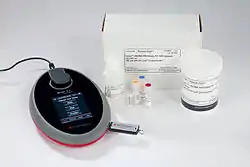Qubit fluorometer
The Qubit fluorometer is a lab instrument developed and distributed by Invitrogen (now part of Thermo Fisher) that, among other applications, is used for the quantification of DNA, RNA, and protein.[1][2][3][4]

Principle
The Qubit fluorometer uses fluorescent dyes to determine the concentration of either nucleic acids or proteins in a sample. The other common method of measuring the concentration of nucleic acids and protein is the UV-absorbance method, which uses a spectrophotometer to measure the natural absorbance of light at 260 nm (for DNA and RNA) or 280 nm (for proteins). Because so many molecules absorb light at 260 nm, this measurement is subject to inaccuracy due to potential contamination of the sample with these other molecules and is unable to distinguish between DNA, RNA, protein or free nucleotides or amino acids in the sample.[5][6][7][8] On the other hand, Qubit system is supplied with fluorescent dyes that bind specifically to analytes of interest such as double-stranded DNA (dsDNA), single-stranded DNA (ssDNA), RNA, miRNA or protein providing more accurate quantification.
Fluorescent dyes
The Qubit assays (previously known as Quant-iT) were developed and manufactured by the previous Molecular Probes (now a part of Life Technologies). Each dye is specific for one type of molecule (DNA, RNA or protein). They have extremely low fluorescence until bound to their target molecule. The difference in fluorescence between bound and unbound dye is several orders of magnitude. Upon binding to DNA, probably by intercalation between the bases, the dye molecules (PicoGreen) assume a more rigid shape and become intensely fluorescent.[9][10] Once added to a solution of DNA, the Qubit DNA dye binds to the DNA within seconds and reaches equilibrium in less than two minutes.
At a specific concentration of the dye, the intensity of the fluorescence signal from this mixture is directly proportional to the concentration of DNA in the solution, even in the presence of other bio-molecules. The Qubit fluorometer picks this fluorescence signal up and converts it into a DNA concentration measurement by referring to DNA probes of known concentration. It then uses this relationship to calculate the concentration of a sample.

The Qubit quantitation system includes the following dyes that are specific for different bio-molecules and concentrations (ds stands for double-stranded, ss for single-stranded DNA):
| Reagent/Assay | Assay range | Sample starting concentration range |
|---|---|---|
| Qubit dsDNA HS Assay | 0.2–100 ng | 10 pg/μl–100 ng/μl |
| Qubit dsDNA BR Assay | 2–1,000 ng | 100 pg/μl–1 μg/μl |
| Qubit ssDNA Assay | 1-200 ng | 50 pg/µL-200 ng/µL |
| Qubit RNA Assay | 5–100 ng | 250 pg/μl–100 ng/μl |
| Qubit RNA BR Assay | 20–1,000 ng | 1 ng/µ-1 µg/µL |
| Qubit Protein Assay* | 0.25–5 μg | 12.5 μg/ml–5 mg/ml |
Comparison with other devices
Other fluorometers can also measure the fluorescence from the Qubit dyes and can be used for DNA, RNA and protein quantification in the same way. However, all other fluorometers require the user to use several DNA standards and plot the concentration versus the absorbance on a graph. The data must then be fitted to a line and finally the sample concentration calculated from the equation of the line. Although this is a simple calculation for any scientist, the Qubit fluorometer does this calculation for the user, making it faster and easier, in addition to being less expensive than a typical fluorometer.
Versions
The second generation, the Qubit 2.0 Fluorometer, was released in 2010, the 3rd generation as Qubit 3.0 in 2014. The newest version is Qubit 4 which was launched in 2017.
References
- Acar E, et al. (2009). "Optimization and validation studies of the MentypeR Argus X-8 kit for paternity cases". Forensic Sci Int Genet Suppl. 2: 47–48. doi:10.1016/j.fsigss.2009.08.189.
- Bakos J, et al. (2009). "Enriched environment influences hormonal status and hippocampal brain derived neurotrophic factor in a sex dependent manner". Neuroscience. 164 (2): 788–797. doi:10.1016/j.neuroscience.2009.08.054. PMID 19723563. S2CID 23809910.
- Halaihel N, et al. (2009). "A new real time PCR-based assay for diagnosing Renibacterium salmoninarum in rainbow trout (Oncorhynchus mykiss) and comparison with other techniques". J Microbiol Meth. 76 (1): 75–80. doi:10.1016/j.mimet.2008.09.014. PMID 18938198.
- Hamza IA, et al. (2009). "Detection and quantification of human bocavirus in riverwater". J Gen Virol. 90 (Pt 11): 2634–2637. doi:10.1099/vir.0.013557-0. PMID 19656966.
- Manchester, K.L. (1996). "Use of UV methods for the measurement of protein and nucleic acid concentrations". BioTechniques. 20 (6): 968–970. doi:10.2144/96206bm05. PMID 8780864.
- Glasel, J.A. (1995). "Validity of nucleic acid purities monitored by 260 nm/280 nm absorbance ratios". BioTechniques. 18 (1): 62–63. PMID 7702855.
- Huberman, J.A. (1995). "Importance of measuring nucleic acid absorbance at 240 nm as well as at 260 and 280 nm". BioTechniques. 18 (4): 636. PMID 7598897.
- Manchester, K.L. (1995). "Value of A260/A280 ratios for measurement of purity of nucleic acids". BioTechniques. 19 (2): 208–210. PMID 8527139.
- McKnight, R.E., Gleason, A.B., Keyes, J.A., Sahabi, S. (2006). "Binding mode and affinity studies of DNA-binding agents using topoisomerase I DNA unwinding assay". Bioorganic & Medicinal Chemistry Letters. 17 (4): 1013–1017. doi:10.1016/j.bmcl.2006.11.038. PMID 17157016.CS1 maint: multiple names: authors list (link)
- Schweitzer, C., Scaiano, J.C. (2003). "Selective binding and local photophysics of the fluorescent cyanine dye PicoGreen in double-stranded and single-stranded DNA". Physical Chemistry Chemical Physics. 5 (21): 4911–4917. doi:10.1039/b305921a.CS1 maint: multiple names: authors list (link)